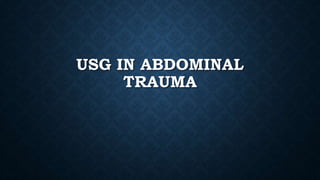
Usg in abdominal trauma.pptx
- 2. ABDOMINAL TRAUMA 1.Trauma causes 10% of deaths world wide 2.Third commonest cause of death after malignancy and vascular disease
- 3. MECHANISM OF INJURY • Direct impact or movement of organs • Compressive , stretching or shearing forces • Solid organs > Blood loss • Hollow organs > Blood loss • Retroperitoneal > often asymptomatic
- 4. ABDOMINAL TRAUMA – CLASSIFICATION 1.BLUNT ABDOMINAL TRAUMA *VEHICULAR TRAUMA *BLOW TO THE ABDOMEN *FALL FROM HEIGHT *DOMESTIC ACCIDENTS *FIGHTS *IATOROGENIC
- 6. PENETRATING ABDOMINAL TRAUMA 1.ACCIDENTAL 2.HOMICIDAL 3.IATROGENIC 4.STAB WOUNDS 5.GUN SHOT WOUNDS 6.SHRAPNEL WOUNDS 7.IMPALEMENTS
- 7. VECTORS OF FORCE • RIGHT SIDED MIDLINE LEFT SIDED RIGHT HEPATIC LOBE LEFT HEPATIC LOBE SPLEEN RIGHT KIDNEY PANCREATIC BODY LEFT KIDNEY DIAPHRAGM PANCREATIC HEAD AORTA DIAPHRAGM DUODENUM TRANSVERSE COLON PANCREATIC TAIL IVC DUODENUM SMALL BOWEL
- 8. HOW TO SCAN • Patient placed in supine position • Low frequency curvilinear probe • Transducer marker • Longitudinal ---- Towards head • Transverse – To patient right
- 9. FAST APPLICATION INDICATIONS : 1.ACUTE BLUNT OR PENETRATING TORSO TRAUMA 2.TRAUMA IN PREGNANCY 3. PAEDIATRIC TRAUMA 4. SUACUTE TORSO TRAUMA
- 10. FAST USG SCAN • ANATOMY • TECHNIQUE • FAST DEMO • FREE FLUID • ABDOMINAL ORGAN INJURY
- 11. FLUID IN THE MORRISONS POUCH
- 12. BLOOD IN DOUGLASS POUCH
- 13. FLUID IN PELVIS • PELVIS : Longitudinally and transverse axis • Probe placed – transversely than longitudinally • Midline 2 cm superior to the symphysis pubis • Aimed –caudally into the pelvis • Probe facing towards the patients head and right side • Best with some urine in bladder • Evaluating : Bladder , uterus in females , Prostate in male
- 15. WHERE TO SCAN 1.RUQ 2.LUQ 3.SUBXIPHOID 4.SUPRAPUBIC 5.RIGHT 3RD TO 4TH INTERCOSTAL SPACE 6.LEFT 3RD TO 4TH INTERCOSTAL SPACE
- 17. ACR APPROPIATENESS CRITERIA CATEGORY A HAEMODYANAMICALLY UNSTABLE CLINICALLY OBVIOUS MAJOR ABDOMINAL TRAUMA RESUSCITATION WITH VOLUME REPLACEMENT NOT RESPOND TO RESUSCITATION
- 18. HEMODYNAMIC STABILITY ? Unstable INVESTIGATION AVAILIBILITY UNSTABLE FAST—FREE FLUID –NO – CONTINUE RESUSCITATION DPL—BLOOD ---YES --- LAPROTOMY
- 19. CATEGORY B • HEMODYANAMICALLY STABLE -MILD TO MODERATE RESPONSIVE HYPOTENSION -SIGNIFICANT TRAUMA AND HAVE AT –LEAST MODERATE SUSPICION OF INTRABDOMINAL INJURY BASED ON CLINICAL SIGNS AND SYMPTOMS -THESE PATIENTS SHOULD BE EVALUATED BY IMAGING
- 20. HEMODYANAMIC STABILITY? • UNSTABLE --- • INVESTIGATION AVAILIBILITY --- FAST : FREE FLUID ::--- CONTINUE RESUSCITATION ----DPL --- BLOOD --- YES---- LAPROTOMY SIGNIFICANT TRAUMA AND HAVE At least moderate suspicion of intra-abdominal injury based on clinical signs and symptoms .These patients should be evaluated by imaging
- 22. PERIHEPATIC SCAN
- 23. PERISPLENIC SCAN
- 24. PERISPLENIC WINDOW • TRANSDUCER IS PLACED • TRANSDUCER is positioned in left posterior axillary line with the beam in the coronal plane .Demonstrates spleen , kidney and diaphragm
- 26. PELVIC AREA
- 28. MORAVELLE LAVELLE LESSON Typically these lesions are anechoic or hypoechoic. As with a standard hematoma, it can be predominantly echogenic in the acute phase, becoming more hypoechoic as blood products liquefy over time 11. Internal debris, including fat globules, can give rise to echogenic foci or even fluid-fluid levels 1. A capsule of variable thickness may be seen. The shape may range from flat to mass-like.
- 30. •lacerations that involve a hepatic vein are associated with increased risk of arterial injury and need for operative management 8 •although not an injury, periportal edema can be seen associated with liver injuries as patients with higher-grade injuries will have received aggressive fluid resuscitation •lacerations that extend to the porta hepatis increase the risk of bile duct injuries, particularly delayed biliary complications 8
- 31. USG FEATURES OF SPLENIC INJURY
- 33. FAST IDENTIFICATION OF TRAUMATIC LACERATION OF LIVER
- 34. LIVER TRAUMA
- 35. • 1. Haematoma : subcapsular ( 10% • Laceration : capsular tear ( 1 cm , parenchymal length • 2. Haematoma :Subcapsular 10-50% surface area , intraparenchymal ( 10cm • Laceration : 1-3 cm parenchymal length ,(10cm in length • 3. Haematoma : Subcapsular ) 50 % surface area or expanding • . Laceration ) 3cm parenchymal length • 4. Laceration : ) 3 cm parenchymal depth • Laceration or parenchymal disruption 25-75% of hepatic lobe
- 38. BILE DUCT INJURY
- 39. SYMPTOMS OF RIGHT UPPER QUADRANT PATHOLOGY •Sudden and rapidly intensifying pain in the upper right portion of your abdomen. •Sudden and rapidly intensifying pain in the center of your abdomen, just below your breastbone. •Back pain between your shoulder blades. •Pain in your right shoulder. •Nausea or vomiting
- 40. USG FEATURES OF KIDNEY INJURY
- 41. USG SIGNS OF KIDNEY INJURY
- 42. SYMPTOMS OF BLADDER INJRY •Lower abdominal pain. •Abdominal tenderness. •Bruising at the site of injury. •Blood in the urine. •Bloody urethral discharge. •Difficulty beginning to urinate or inability to empty the bladder. •Leakage of urine. •Painful urination
- 44. THANK YOU